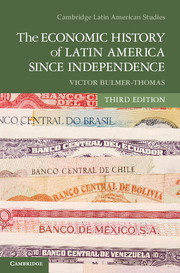Book contents
- Frontmatter
- Dedication
- Contents
- List of Tables, Figures, and Maps
- Preface to the Third Edition
- Preface to the First Edition
- List of Abbreviations
- 1 Latin American Economic Development
- 2 The Struggle for National Identity
- 3 The Export Sector and the World Economy, circa 1850–1914
- 4 Export-Led Growth
- 5 Export-Led Growth and the Nonexport Economy
- 6 The First World War and Its Aftermath
- 7 Policy, Performance, and Structural Change in the 1930s
- 8 War and the New International Economic Order
- 9 Inward-Looking Development in the Postwar Period
- 10 New Trade Strategies and Debt-Led Growth
- 11 Debt, Adjustment, and the Shift to a New Paradigm
- 12 Conclusions
- Appendix 1 Data Sources for Population and Exports before 1914
- Appendix 2 The Ratio of Exports to Gross Domestic Product, the Purchasing Power of Exports, the Net Barter Terms of Trade, and the Volume of Exports, circa 1850 to circa 1912
- Appendix 3 Population, Exports, Public Revenue, and GDP for the Main Latin American Countries before 1914
- Appendix 4 GDP Per Head in Latin America since 1900
- Bibliography
- Index
11 - Debt, Adjustment, and the Shift to a New Paradigm
Published online by Cambridge University Press: 05 June 2014
- Frontmatter
- Dedication
- Contents
- List of Tables, Figures, and Maps
- Preface to the Third Edition
- Preface to the First Edition
- List of Abbreviations
- 1 Latin American Economic Development
- 2 The Struggle for National Identity
- 3 The Export Sector and the World Economy, circa 1850–1914
- 4 Export-Led Growth
- 5 Export-Led Growth and the Nonexport Economy
- 6 The First World War and Its Aftermath
- 7 Policy, Performance, and Structural Change in the 1930s
- 8 War and the New International Economic Order
- 9 Inward-Looking Development in the Postwar Period
- 10 New Trade Strategies and Debt-Led Growth
- 11 Debt, Adjustment, and the Shift to a New Paradigm
- 12 Conclusions
- Appendix 1 Data Sources for Population and Exports before 1914
- Appendix 2 The Ratio of Exports to Gross Domestic Product, the Purchasing Power of Exports, the Net Barter Terms of Trade, and the Volume of Exports, circa 1850 to circa 1912
- Appendix 3 Population, Exports, Public Revenue, and GDP for the Main Latin American Countries before 1914
- Appendix 4 GDP Per Head in Latin America since 1900
- Bibliography
- Index
Summary
The Mexican government's August 1982 threat of default on its external public debt was the trigger that finally unleashed the debt crisis. The net flow of bank lending to Latin America ground to a halt, and the net transfer of resources suddenly turned negative. Even countries like Colombia, which had been prudent about accumulating foreign-debt obligations, were affected as private financial institutions in the developed countries reversed their previously optimistic forecasts concerning Latin America.
The decline in bank lending set in motion a chain of events that was to lead by the end of the decade to a New Economic Model (NEM), based on export-led growth and a smaller role for the state, for the majority of republics. The transition to a new trajectory was not painless. Yet countries had few alternatives, for the logic of the situation demanded a response from governments all along the political spectrum. Only in energy-rich Venezuela under President Chávez (1999–2013) was it feasible to run an economy in which the state was largely responsible for capital accumulation and where the inefficiencies and waste associated with the model were numerous. The NEM emerged in part as a pragmatic response to the series of adjustment and stabilization programs adopted in each republic in the 1980s. Forced by the negative transfer of resources to accumulate trade surpluses, Latin American republics finally gave higher priority to the question of export promotion, which had been on the agenda in most republics since the 1960s. Unable to borrow funds abroad, governments also began to address the problems of fiscal reform, inefficient state-owned enterprises, and indiscriminate subsidies.
- Type
- Chapter
- Information
- The Economic History of Latin America since Independence , pp. 391 - 435Publisher: Cambridge University PressPrint publication year: 2014

